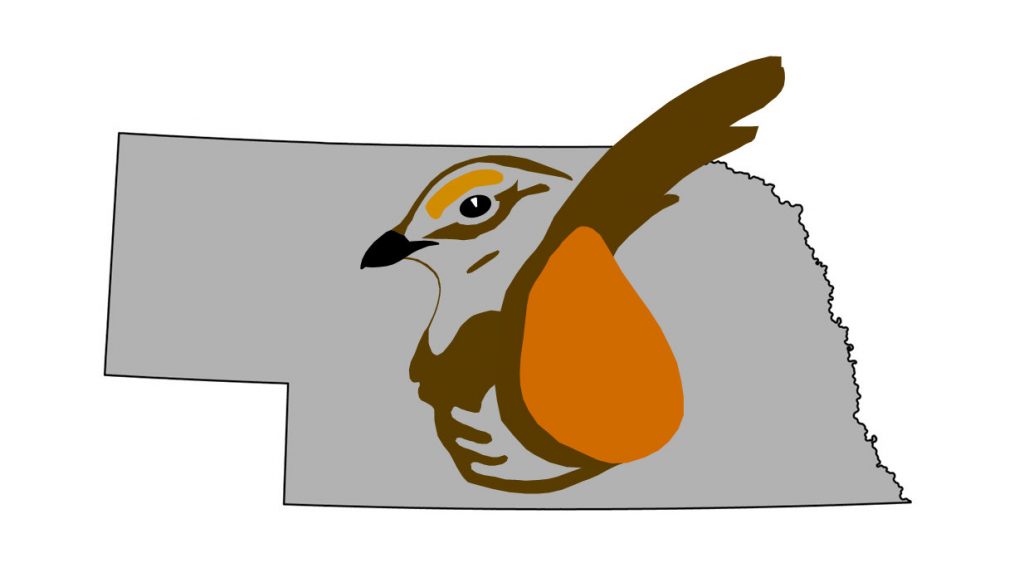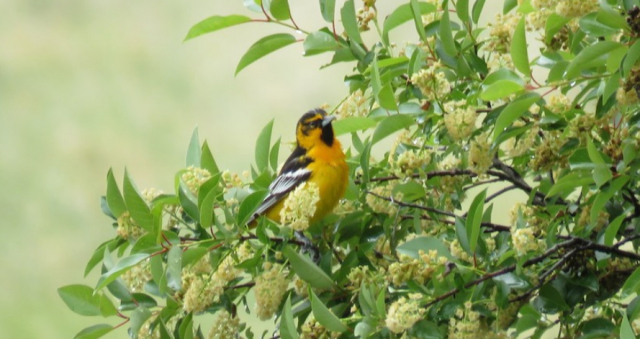Icterus bullockii x ICTERUS galbula
Status: Uncommon regular summer visitor west and west central, rare casual elsewhere.
Summer: May 6, 8, 8 <<<>>> Jul 25, 26, 28
Later dates are 4 Aug 2012 Red Willow Co, 7 Aug 2020 Keith Co, 7-26 Aug 2024 at three Lake Mcconaughy, Keith Co locations, 29 Aug 2021 Rock Creek SRA, Dundy Co, two there 29 Aug 2022, and one at Wildcat Hills NC, Scotts Bluff Co 4 Sep 2022.
The last dates above are not much earlier than departure of Bullock’s Oriole (11-12 Sep) and Baltimore Oriole (4-6 Sep in the west); perhaps hybrids are at a disadvantage timing migration.
Records for the east and east central are 14 May 2014 Antelope Co, 16 May 2024 Buffalo Co, 17 May 2021 York Co, and 30 Aug 2023 in Buffalo Co.
Comments: Hybridization occurs between this species and Baltimore Oriole (Rising 1970, 1996; Carling et al 2011; Walsh et al 2020), causing at one time their taxonomic status to be controversial. AOU (1983) lumped them as a single species, Northern Oriole, but returned both to full species status (AOU 1998) based on absence of free interbreeding at some locations resulting in a stable hybrid zone (Rising 1996, Carling et al 2011, Walsh et al 2020, Walsh et al 2023). Furthermore, “the two species differ in plumage, vocalizations, physiologic traits, molt, nesting ecology, and allozyme frequency to a degree greater than in any other birds generally treated as single species” (DeBenedictis 1996). One factor limiting expansion of the hybrid zone is lowered fitness of hybrids; one cause of this is that Baltimore Oriole molts in summer and Bullock’s in fall, but hybrids molt twice, a significant energy drain (Rohwer and Johnson 1992, Flood et al 2020), and another is the putative difference between the two species in ability to thermo-regulate (Carling et al 2011, Rising 1996). A whole genome study by Walsh et al (2023) discovered a “large putative” inversion on the Z chromosome in their series of Bullock’s, Baltimore, and hybrid orioles from the hybrid zone in southwestern Nebraska and northeastern Colorado; this inversion was hypothesized to be an impediment to hybrid fitness, along with additional “findings of complex and coupled interactions between pre- and post-mating barriers [suggesting] a relatively rapid accumulation of barriers between these species”.
Walsh et al (2020, 2023) found that the center of the hybrid zone has moved westward since the 1950s and narrowed to less than 100 miles, its center located around Crook, Colorado, south of Cheyenne Co, Nebraska. Carling et al (2011) estimated hybrid zone width nearer to 200 miles. The presence of phenotypically pure adults of both Bullock’s and Baltimore Oriole in the hybrid zone suggests assortative mating is occurring (Carling et al 2011, Flood et al 2020). Although Walsh et al (2020) found that “nearly all orioles within the hybrid zone” exhibited some degree of genomic mixing, and “41% [were] assigned as recent-generation (F1/F2) hybrids”, these F1/F2 hybrids were found in the center of the hybrid zone, bordered on each edge of the zone by introgressants, suggesting assortative mating in the center of the zone with surviving introgressants limited to the zone edges. Walsh et al (2020, 2023), in genomic studies, found that “classically scored plumage traits are an accurate predictor of pure vs. hybrid genotypes”, and found evidence for introgression in orioles collected in eastern Nebraska, likely remnants of previous hybridization events. Walsh et al (2020) noted “a longer tail of introgression from Bullock’s Orioles in the west into Baltimore Orioles in the east. Short (1965) found “hybrids” in eastern Nebraska (see below).
Environmental factors are known to affect the locations of the Great Plains avian hybrid zones (Swenson 2006), and intriguingly, similar westward movements to those documented in the orioles (Corbin and Sibley 1977, Walsh et al 2020) have previously been documented in flickers (Aguillon and Rohwer 2021) and the hybrid zone between the Lazuli (Passerina amoena) and Indigo (P. cyanea) buntings (Carling and Zuckerberg 2011).
Short (1961) considered the hybrid zone rather wide in Nebraska, with its center a line from Big Springs, Deuel Co to just west of Valentine, Cherry Co (see map above). Short found pure Baltimore Orioles west to Hastings, Adams Co, St. Paul, Howard Co, and Spencer, Boyd Co, and pure Bullock’s Orioles east only to Chadron, Dawes Co, and Big Springs. However, hybrids outnumbered pure Baltimore Orioles east as far as Blair, Washington Co, and “obvious hybrids” occur in the northwest in summer (Rosche 1982). Youngworth (1955) and Mossman and Brogie (1983) found Baltimore Orioles predominant in the Niobrara Valley Preserve, although hybrids were seen during breeding season. Intriguingly, there is a nest record for Bullock’s Oriole for Brown Co in 1898, but details of identification of the parents are not available (Mollhoff, pers. comm.; Mollhoff 2022); it seems quite likely this nesting was by hybrids or a mixed Baltimore x hybrid pair. An interesting nesting was monitored near Valentine, Cherry Co; both parents appeared to be hybrids, but the female of the pair disappeared, leaving the male to successfully fledge the two chicks 9 Jul (Gordon Warrick, personal communication). A female seen in the area 8 Jun was not one of the presumptive parents (Gordon Warrick). Both Baltimore and Bullock’s Orioles have been reported at NNF Bessey, Thomas Co (Bray 1994); a hybrid was there 11 Jun 1986. Jaramillo and Burke (1999) stated “If anything, there is evidence for an eastward invasion of Bullock’s genes, but not the opposite”. In Keith Co, Brown et al (1996) found that 116 of 176 birds examined (not all were nesting birds) were phenotypic Baltimore Orioles, and 41 showed evidence of hybridization, the remainder apparent Bullock’s Orioles. Of six orioles seen on the Dalton BBS route 18 Jun 2006, five were hybrids, the other a female Bullock’s Oriole. It is possible that the incidence of Bullock’s Oriole and introgressants east of the Panhandle has been reduced since the westward range expansion of Baltimore Oriole (Corbin and Sibley 1977).
Observations in Scotts Bluff Co suggest that as Baltimore Orioles moved west in the 1980s and came in contact with Bullock’s, hybrids were common, possibly since the first birds westward may have been mostly males (as was the case with Blue Jays after they entered northeastern Colorado, Bill Kaempfer, pers. comm.) but as numbers of Baltimore Orioles increased in western Nebraska and assortative mating became an option, hybrids became less common. This sequence was observed in a Mitchell, Scotts Bluff Co yard by Kathy DeLara (pers. comm.); there was a Bullock’s paired with a Baltimore in 2007 and numerous hybrids for several years, but only one hybrid in 2017 and none in 2018 and no phenotypic Baltimores during those two years.
Recent genetic studies suggest that the closest relative of Baltimore Oriole is actually Black-backed (Abeille’s) Oriole (Icterus abeillei) and that Bullock’s Oriole is a member of the Streak-backed Oriole complex (Flood et al 2020). Steven Mlodinow made an interesting point about the possibility of intergrades between Black-backed and Bullock’s Orioles occurring north of Mexico. Black-backed and Bullock’s interbreed in Mexico, where Black-backed is only a short distance migrant, whereas Bullock’s is a longer distance migrant to North America. Hybrids and intergrades between migratory and non-migratory species may or may not migrate, although a mostly Bullock’s backcross could quite likely migrate north with Bullock’s Orioles. An individual reported as “Bullock’s/Black-backed Oriole” that “looked a bit like both species” was at Sutherland Reservoir, Lincoln Co 21 Jun 2022 (Mlodinow, eBird.org).
Images
Literature Cited
Aguillon, S.M., and V.G. Rohwer. 2021. Revisiting a classic hybrid zone: rapid movement of the northern flicker hybrid zone in contemporary times. bioRxiv preprint doi: https://doi.org/10.1101/2021.08.16.456504.
American Ornithologists’ Union [AOU]. 1983. The AOU Check-list of North American birds, 6th ed. Allen Press, Lawrence, Kansas, USA.
American Ornithologists’ Union [AOU]. 1998. The AOU Check-list of North American birds, 7th ed. Allen Press, Lawrence, Kansas, USA.
Bray, T.E. 1994. Habitat utilization by birds in a man-made forest in the Nebraska Sandhills. M.S. thesis, University of Nebraska-Omaha.
Brogie, M.A., and M.J. Mossman. 1983. Spring and summer birds of the Niobrara Valley Preserve, Nebraska: An annotated checklist. NBR 51: 44-51.
Brown, C.R., M.B. Brown, P.A. Johnsgard, J. Kren, and W.C. Scharf. 1996. Birds of the Cedar Point Biological Station area, Keith and Garden Counties, Nebraska: Seasonal occurrence and breeding data. Transactions of the Nebraska Academy of Sciences 23: 91-108.
Carling, M.D., L.G. Serene, and I J. Lovette. 2011. Using historical DNA to characterize hybridization between Baltimore Orioles (Icterus galbula) and Bullock’s Orioles (I. bullockii). Auk 128: 61-68.
Carling, M.D., and B. Zuckerberg. 2011. Spatio-temporal changes in the genetic structure of the Passerina bunting hybrid zone. Molecular Ecology 20: 1166-1175.
Corbin, K. W. and C. G. Sibley. 1977. Rapid evolution in orioles of the genus Icterus. Condor 79: 335-342.
DeBenedictis, P.A. 1996. Fortieth supplement to the AOU check-list. Birding 28: 228-231.
Flood, N.J., C.L. Schlueter, M.W. Reudink, P. Pyle, M.A. Patten, J.D. Rising, and P.L. Williams. 2020. Bullock’s Oriole (Icterus bullockii), version 1.0. In Birds of the World (P. G. Rodewald, Editor). Cornell Lab of Ornithology, Ithaca, NY, USA. https://doi.org/10.2173/bow.bulori.01.
Jaramillo, A., and P. Burke. 1999. New World Blackbirds- The Icterids. Princeton University Press, Princeton, New Jersey, USA.
Mollhoff, W.J. 2022. Nest records of Nebraska birds. Nebraska Ornithologists’ Union Occasional Paper Number 9.
Mossman, M.J., and M.A. Brogie. 1983. Breeding status of selected bird species on the Niobrara Valley Preserve, Nebraska. NBR 51: 52-62.
Rising, J.D. 1970. Morphological variation and evolution in some North American orioles. Systematic Zoology 19: 315-351.
Rising, J.D. 1996. The stability of the oriole hybrid zone in western Kansas. Condor 98: 658-663.
Rohwer, S., and M.S. Johnson. 1992. Scheduling differences of molt and migration for Baltimore and Bullock’s orioles persist in a common environment. Condor 94: 992-994.
Rosche, R.C. 1982. Birds of northwestern Nebraska and southwestern South Dakota, an annotated checklist. Cottonwood Press, Crawford, Nebraska, USA.
Short, L.L., Jr. 1961. Notes on bird distribution in the central Plains. NBR 29: 2-22.
Swenson, N. G. 2006. Gis-based niche models reveal unifying climatic mechanisms that maintain the location of avian hybrid zones in a North American suture zone. Journal of Evolutionary Biology 19:717–25.
Walsh, J., S.M. Billerman, V.G. Rohwer, B.G. Butcher, and I.J. Lovette. 2020. Genomic and plumage variation across the controversial Baltimore and Bullock’s oriole hybrid zone. Auk 137: 1–15. DOI: 10.1093/auk/ukaa044.
Walsh, J., S.M. Billerman, B.G. Butcher, V.G. Rohwer, D.P.L. Toews, V. Vila-Coury, and I.J. Lovette. A complex genomic architecture underlies reproductive isolation in a North American oriole hybrid zone.
Communications Biology 6, 154. https://doi.org/10.1038/s42003-023-04532-8.
Youngworth, W. 1955. Some birds of the Quicourt Valley. NBR 23: 29-34.
Recommended Citation
Silcock, W.R., and J.G. Jorgensen. 2025. Bullock’s x Baltimore Oriole (hybrid) (Icterus bullockii x galbula). In Birds of Nebraska — Online. www.BirdsofNebraska.org
Updated 24 Jun 2025
